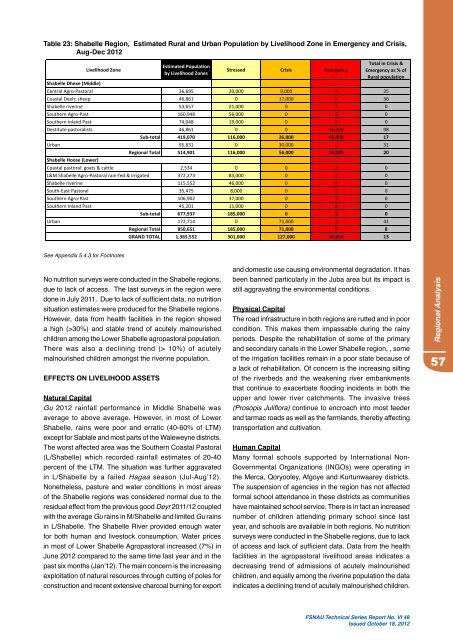Fsnau-Post-Gu-2012-Technical-Report
Fsnau-Post-Gu-2012-Technical-Report
Fsnau-Post-Gu-2012-Technical-Report
Create successful ePaper yourself
Turn your PDF publications into a flip-book with our unique Google optimized e-Paper software.
Table 23: Shabelle Region, Estimated Rural and Urban Population by Livelihood Zone in Emergency and Crisis,<br />
Aug-Dec <strong>2012</strong><br />
Shabelle Dhexe (Middle)<br />
Livelihood Zone<br />
Estimated Population<br />
by Livelihood Zones<br />
Stressed Crisis Emergency<br />
Total in Crisis &<br />
Emergency as % of<br />
Rural population<br />
Central Agro‐Pastoral 36,695 20,000 9,000 0 25<br />
Coastal Deeh: sheep 46,861 0 17,000 0 36<br />
Shabelle riverine 53,657 21,000 0 0 0<br />
Southern Agro‐Past 160,948 56,000 0 0 0<br />
Southern Inland Past 74,048 19,000 0 0 0<br />
Destitute pastoralists 46,861 0 0 46,000 98<br />
Sub‐total 419,070 116,000 26,000 46,000 17<br />
Urban 95,831 0 30,000 0 31<br />
Regional Total 514,901 116,000 56,000 46,000 20<br />
Shabelle Hoose (Lower)<br />
Coastal pastoral: goats & cattle 2,534 0 0 0 0<br />
L&M Shabelle Agro‐Pastoral rain‐fed & irrigated 372,273 83,000 0 0 0<br />
Shabelle riverine 115,552 46,000 0 0 0<br />
South‐East Pastoral 35,475 8,000 0 0 0<br />
Southern Agro‐Past 106,902 37,000 0 0 0<br />
Southern Inland Past 45,201 11,000 0 0 0<br />
Sub‐total 677,937 185,000 0 0 0<br />
Urban 172,714 0 71,000 0 41<br />
Regional Total 850,651 185,000 71,000 0 8<br />
GRAND TOTAL 1,365,552 301,000 127,000 46,000 13<br />
See Appendix 5.4.3 for Footnotes<br />
No nutrition surveys were conducted in the Shabelle regions,<br />
due to lack of access. The last surveys in the region were<br />
done in July 2011. Due to lack of sufficient data, no nutrition<br />
situation estimates were produced for the Shabelle regions.<br />
However, data from health facilities in the region showed<br />
a high (>30%) and stable trend of acutely malnourished<br />
children among the Lower Shabelle agropastoral population.<br />
There was also a declining trend (> 10%) of acutely<br />
malnourished children amongst the riverine population.<br />
EFFECTS ON LIVELIHOOD ASSETS<br />
Natural Capital<br />
<strong>Gu</strong> <strong>2012</strong> rainfall performance in Middle Shabelle was<br />
average to above average. However, in most of Lower<br />
Shabelle, rains were poor and erratic (40-60% of LTM)<br />
except for Sablale and most parts of the Waleweyne districts.<br />
The worst affected area was the Southern Coastal Pastoral<br />
(L/Shabelle) which recorded rainfall estimates of 20-40<br />
percent of the LTM. The situation was further aggravated<br />
in L/Shabelle by a failed Hagaa season (Jul-Aug’12).<br />
Nonetheless, pasture and water conditions in most areas<br />
of the Shabelle regions was considered normal due to the<br />
residual effect from the previous good Deyr 2011/12 coupled<br />
with the average <strong>Gu</strong> rains in M/Shabelle and limited <strong>Gu</strong> rains<br />
in L/Shabelle. The Shabelle River provided enough water<br />
for both human and livestock consumption. Water prices<br />
in most of Lower Shabelle Agropastoral increased (7%) in<br />
June <strong>2012</strong> compared to the same time last year and in the<br />
past six months (Jan’12). The main concern is the increasing<br />
exploitation of natural resources through cutting of poles for<br />
construction and recent extensive charcoal burning for export<br />
and domestic use causing environmental degradation. It has<br />
been banned particularly in the Juba area but its impact is<br />
still aggravating the environmental conditions.<br />
Physical Capital<br />
The road infrastructure in both regions are rutted and in poor<br />
condition. This makes them impassable during the rainy<br />
periods. Despite the rehabilitation of some of the primary<br />
and secondary canals in the Lower Shabelle region, , some<br />
of the irrigation facilities remain in a poor state because of<br />
a lack of rehabilitation. Of concern is the increasing silting<br />
of the riverbeds and the weakening river embankments<br />
that continue to exacerbate flooding incidents in both the<br />
upper and lower river catchments. The invasive trees<br />
(Prosopis Juliflora) continue to encroach into most feeder<br />
and tarmac roads as well as the farmlands, thereby affecting<br />
transportation and cultivation.<br />
Human Capital<br />
Many formal schools supported by International Non-<br />
Governmental Organizations (INGOs) were operating in<br />
the Merca, Qoryooley, Afgoye and Kurtunwaarey districts.<br />
The suspension of agencies in the region has not affected<br />
formal school attendance in these districts as communities<br />
have maintained school service. There is in fact an increased<br />
number of children attending primary school since last<br />
year, and schools are available in both regions. No nutrition<br />
surveys were conducted in the Shabelle regions, due to lack<br />
of access and lack of sufficient data. Data from the health<br />
facilities in the agropastoral livelihood areas indicates a<br />
decreasing trend of admissions of acutely malnourished<br />
children, and equally among the riverine population the data<br />
indicates a declining trend of acutely malnourished children.<br />
FSNAU <strong>Technical</strong> Series <strong>Report</strong> No. VI 48<br />
Issued October 18, <strong>2012</strong><br />
Regional Analysis<br />
57


